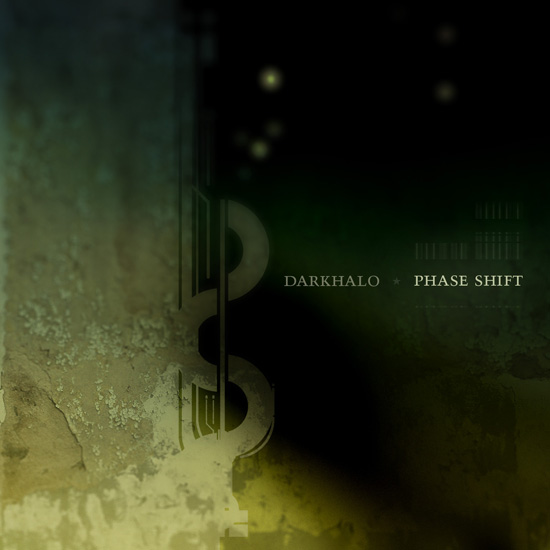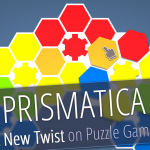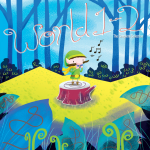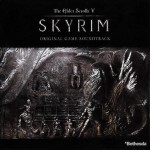After a long absence from the music scene with only a string of releases over the course of the past few years, Darkhalo (a.k.a. Josh Barnett) has triumphantly returned with a new full-length album called Phase Shift, his first release for the Mephtik netlabel. Mephtik is known for releasing music with a strong emphasis on demoscene flavor, and this album is no exception. Darkhalo has been well-known in demoscene circles since the late ’90s for his proficient takes on two opposing genres, ambient and drum ‘n’ bass.
Phase Shift continues this tradition by balancing the album between chilled-out atmospheres and skittering in-your-face beats. With over an hour of music, it’s stacked with elements of ambient, DnB, house, breakbeat, and funk styles, all in a cohesive electronic package. Let’s get to the album!
Read our advance review of Darkhalo’s Phase Shift after the jump.
The leading track, “Petabyte Flow,” introduces the album’s mission statement. It kicks off with chilly string swells, then a few bleeps and bloops introduce the metallic aspect of the track and we’re off–a two-step beat drops and a high arpeggio threads in and out. It gets heavier from there as the strings become more tense and a vocoded voice spits out some muffled word fragments. It’s clear that the goal of this track is to introduce elements heard throughout the rest of the album, and in that way it functions like an overture. “Ghosts of the Past” slows down the pace with a mid-tempo swing beat and a great deal of atmosphere. The sounds of nature and city ambiance gel with reverberant percussion and pads to create a feeling like walking through a future city. “Binary Space Partition” forgoes a beat in the intro and starts with bell synths instead. After a short build-up, a back-and-forth DnB-meets-breakbeat rhythm enters and leads into some straight-ahead DnB. The blips of the opening track return and lend a melodic aspect to the song.
After the funked-up swing of interlude track “Stasis,” “Konpeito” enters with a very funky take on chill that wouldn’t sound out of place on one of LTJ Bukem’s “Earth” compilation albums. Slap bass percolates and jazzy seventh-chords back a smooth, very danceable beat. The song displays the melodic sensibility that is often restrained in the colder, more robotic songs. Speaking of robotic songs, they don’t get more robotic than “Mind of Goborobo,” a fun house tune where the song’s vocoded, Speak-and-Spell protagonist even takes the mic–“Go, go-go-go!” “Great!” The jazzy nature of the previous song bleeds over into this one and warms it up. Marimba accents spice things up with some rhythmic melody as syncopated chord stabs fill out the beat.
Enough warmth, it’s time to return to the coldness of the more factory-oriented nature that processed electronics can create. There’s something slightly menacing brewing beneath the surface of “ii yo,” and the distorted snatches of vocals reinforce that idea. Diminished chords play as the song grows more and more glitched-out. For oldschool gamers, this is like a Sonic boss fight colliding with Streets of Rage. Funky, but evil! “Trailing Through the Sky”‘s rich pads and walking pace mark a return to an emphasis on atmosphere. The drums in this track feel more organic than anything that has come before, and it feels like we’re outside of the city, surveying the dusky evening sky from the fields. The syncopated pads create a sensation like flying–a temporary escape from the confines of urban living.
Back to work. The vacation couldn’t last forever! “Minima” is true to its name, both because its chopped-up robotic female vocalist actually says “minima,” and because it’s quite a minimalistic tune. This is ‘compact’ music that doesn’t leave its cubicle; this is the sound of old school techno, complete with 808 drums. “Tension” doesn’t waste any time setting an eerie mood with strings, static hums, and filtered beats. It’s the cinematic sound of risky plans put into action, very carefully. There’s an unforeseen kink in the plans and the results play out in the album’s namesake, “Phase Shift.” Introduced by what sounds like a heartbeat, a heavy beat stutters in, the tension from the previous track continues, the bleeps and bloops are back, and a distorted filter bass gets chopped up… over and over, the root note of the song is emphasized. There is a singular purpose here–focus can’t be lost. This track in particular showcases Darkhalo’s demoscene roots and could easily be at home in a very technical demo.
An uptempo high-pass filtered beat immediately begins the intro to “Boss Rush [SMB2],” a standout track that reimagines the Super Mario Bros. 2 boss music as a killer techstep rave-up. It’s surprising how threatening the atonal tension in the theme becomes as the track evolves, though it never loses its sense of fun. The song takes a lot of stylistic detours, too. There are half-time breakdowns with video-gamey fighting vocals (“Hoy!” “Ah!”), creepy vibrato synth lines, and wobble bass lines. It’s a very satisfying cut, and my personal favorite from the album, even though it is a break in mood from the rest.
The album ends with its most ambient and downright beautiful track, “Lily.” Slow pads enter, light harp touches abound, and an almost-subliminal soft female voice lends a sense of femininity. So many elements lend to the sense of atmosphere: subtle static clicks, white noise, falling chirps. Halfway through the song, a hum builds into a high-frequency climax and suddenly, we’re treated to the most tonal moment on the album–a IV-I plagal cadence, also known as the ‘Amen cadence’ for its pleasant and pastoral sense of finality. It feels like a homecoming, and it makes for a strong ending.
Anyone with even a passing interest in electronic music from the likes of Roni Size, Future Sound of London, Autechre, et al, should find something to love in Phase Shift. It covers a broad range of styles and genres while remaining focused on an entirely electronic sound. Darkhalo remains true to his demoscene roots while hinting at larger ambitions, which makes this a recommended release.
Tags: Ambient, Darkhalo, Downloads, Drum-n-bass, FREE, Josh Barnett, Music Reviews, Remixers, Remixes, Reviews, Super Mario Bros. 2









































Wohoo. Darkhalo is back. : ) On Mephtik!
Unfreakin believable! Been a fan of Darkhalo for years and this is truly amazing. Definitely worth the wait and will be blasting these tracks in the car and at home.
I find the albums I tend to enjoy best are the ones I didn’t like at all in the beginning. The Miseducation of Lauryn Hill, Regina Lund’s Year Zero, and now Darkhalo’s Phase Shift. What I had been missing in many of Darkhalos mp3s was that strong sense of “feeling” he had in his older mods, and instead an emphasis on sample quality. So I figured this would be the same, and was all I got out of it on the first listen, but after a second try a couple of weeks later my judgement changed. So here you get a review:
Petabyte having just that expression of feeling in the main sound of the song (I’m not so good with music terms), and sounding to me like being influenced by the boss-fights in Super R-Type and some similarity with his 2001 mp3 Stratosphere Sniper.
On the next track Ghosts, begins after half a minute a beat, just a beat, one thinks at first, but if one listens closely is a ghostly sound, a showcase for his attention to details, and it’s often those which make the song. And what else could make the song when you don’t have lyrics or catchyness? Originality. Although one could think that it would be an unsettling song, I find myself enjoying listening to it, it’s sort of like a soundtrack to an eerie place in a quirky adventure game.
Further in Binary we continue in the same manner as the first song with a spacelike mood, and here the gameboy also serves as inspiration. Konpeito starts off with that Steve Roach Structures from Silence sound, and then blends into a kind of snes-rpg shop-music.
Remember me saying darkhalo doesn’t do anything catchy? Well, in Goborobo comes the catchiness he does incorporate in some songs with a dancey tune. ii yo is his venture into IDM, with all the randomness that follows, and the weird samples which was also heard in the song before.
Sky begins with a sunny clockworkdayish synth to next add in a robotic beat and then some very hard cymbals. Nothing more needs to be said, the title reveals it all. It ends with finally reaching the outer reigns of the planet, with again… a sound of “space”, for lack of more spacesynonyms.
Then comes 4 songs that I don’t have much for: Minima goes again back to IDM. Tension builds up… tension, with a clockstriking beat, which doesn’t work very well. It is in nearly the whole song with only small sounds interdispersed, nothing much to listen to. Phase takes the tension further with a Metalgear feel. Rush straight off samples large parts of the original, not what I call good style.
The Final Fantasy VII inspiration can be heard in many tracks, but most so in Lily, which rounds off the album well.